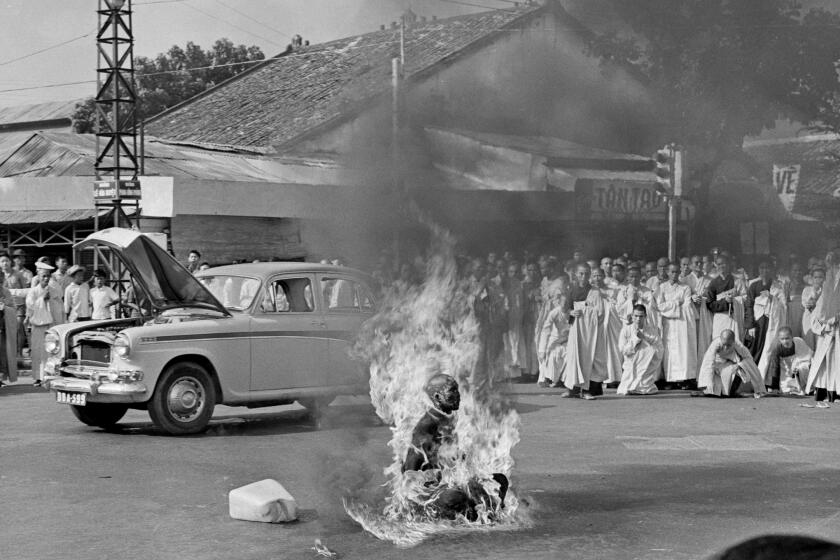Op-Ed: How a voting-rights exception to the filibuster could help shore up our democracy

Our democracy has been gravely challenged in recent years by foreign interference, domestic attacks, widespread voter suppression — and by the filibuster, which can prevent bills that have majority support from becoming law. A simple compromise proposal I call the “voting-rights exception” has the potential to address all of these issues by exempting from the filibuster bills that concern voting rights.
Unlike proposals to eliminate the filibuster, the “voting-rights exception” has a reasonable chance of being implemented.
As it stands, the Senate filibuster gives the minority party the power to block legislation by preventing a vote on a bill. The filibuster originally allowed any senator to debate any bill or confirmation for an unlimited amount of time, so those with enough stamina could talk a bill or confirmation to death.
In the 1939 film “Mr. Smith Goes to Washington,” Jimmy Stewart made the filibuster famous portraying an idealistic senator who talks for 24 hours to prevent the Senate from voting on a corrupt public works bill. In real life, Sen. Strom Thurmond spoke for over 24 hours but managed only to stall the passage of the Civil Rights Act of 1957. He still holds the record for the longest filibuster speech in the U.S. Senate.
A body that grants outsized representation to small states is made even more undemocratic by the filibuster rule.
Over time, the ability to filibuster has been cut back through exceptions and compromise. In 1917, the Senate adopted a process that allowed it to end debate on a bill with a two-thirds majority vote — removing the ability to endlessly filibuster the bill. This is known as “cloture.” If a cloture motion succeeds, the bill goes to the floor for a simple majority vote.
Cloture was first invoked in 1919 to stop a filibuster against the Treaty of Versailles, which ended World War I. In another dramatic example, after 60 days of debate, the Senate used cloture to end a filibuster against the Civil Rights Act of 1964, which prohibited forced segregation and racial discrimination.
Over time, additional exceptions have been added. The War Powers Act of 1973, the Congressional Budget Act, the National Emergencies Act and the Congressional Review Act prevent certain types of bills and congressional actions from being filibustered. For example, both parties have used the Congressional Budget Act’s budget reconciliation process to enact significant parts of their agendas without the threat of a filibuster.
In 1975, the Senate changed its rules to allow cloture to be invoked with three-fifths of all senators. This made it easier to overcome a filibuster by reducing the number of votes needed for cloture to 60, where it remains today. If the cloture motion does not receive the necessary votes from among the current 100 senators, the bill is withdrawn. No one usually has to talk a bill to death, making the “talking filibuster” largely a thing of the past.
In 2013, a Democratic-controlled Senate changed the rules to allow cloture by a simple majority vote for cabinet appointees and judicial nominees, except for nominees to the Supreme Court. With the Republicans in control in 2017, the Senate lowered the cloture threshold for Supreme Court nominees to a simple majority vote. Both of these changes were framed as a simple reinterpretation of the cloture rule and were implemented by a simple majority vote.
This pattern of placing successive incremental limitations on the filibuster gives the Senate a way forward. Here’s how the voting-rights exception could garner the majority support necessary to be implemented.
Currently, the Senate is split 50 to 50. Perhaps as many as 47 Democratic and independent senators support eliminating the filibuster altogether. At least three Democratic senators (Joe Manchin III, Kyrsten Sinema and Jon Tester) have said they oppose eliminating the filibuster, but they have not publicly opposed making limited exceptions. After all, the voting-rights exception would not eliminate the filibuster but rather follow a long practice of placing restrictions on it for important issues.
And there is no more important issue than our democracy. Indeed, it seems contradictory to allow the anti-democratic filibuster to stand in the way of protecting our democracy. The three senators could easily support this proposal and stay true to their commitments, bringing the number to 50. The Democratic vice president, whose constitutional role in the Senate is to break ties, would be the deciding vote.
With the voting rights exception in place, Congress could pass a new Voting Rights Act and other legislation that would expand access to the ballot, safeguard against foreign interference and combat voter suppression. All by a simple majority vote.
A voting rights exception would not enable Democrats to immediately enact their full agenda. But it would strengthen our democracy. It represents a middle ground. For those who want to preserve the filibuster, it does so. For those who want to end it, it is a step forward. It is a compromise worth considering.
Stephen Marks is a professor of law and former associate dean at Boston University School of Law.
More to Read
A cure for the common opinion
Get thought-provoking perspectives with our weekly newsletter.
You may occasionally receive promotional content from the Los Angeles Times.







